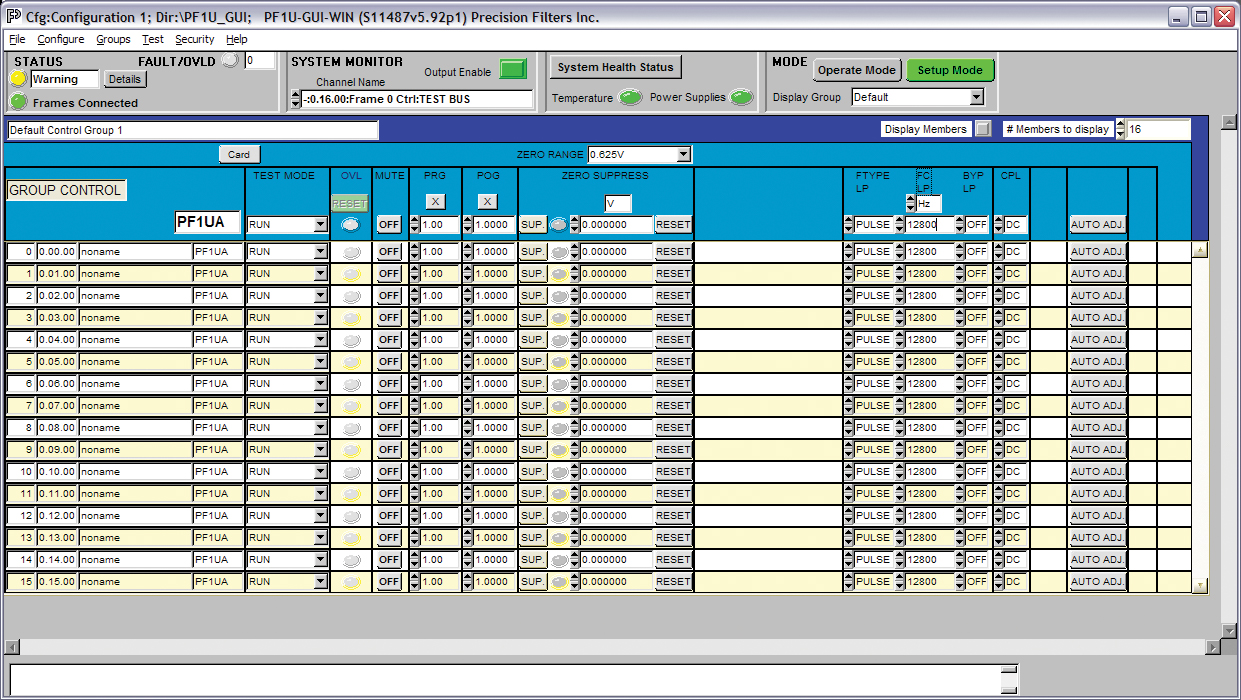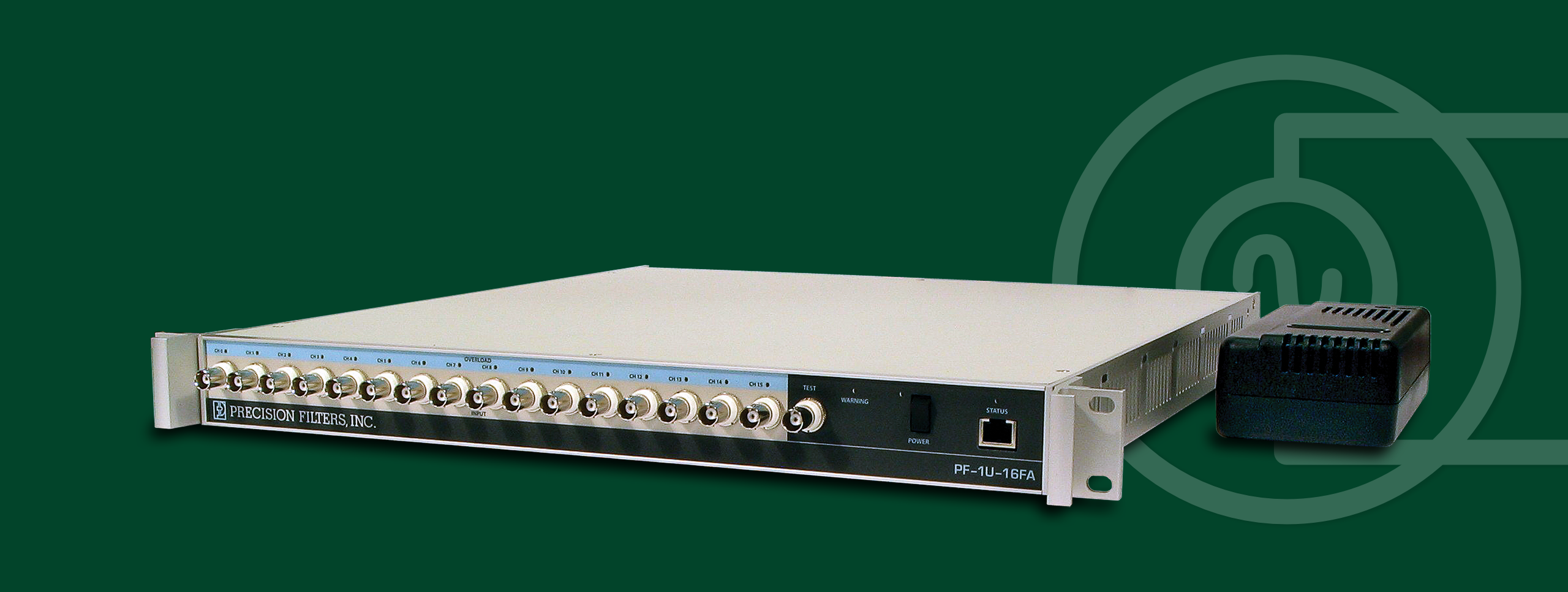PF-1U-FA Multi-Channel Programmable Filter/Amplifier System
The PF-1U-FA Multi-Channel Programmable Filter/Amplifier System is ideal for conditioning low-level voltage inputs in front of high-resolution digital data acquisition systems.
Fully programmable 8-channel and 16-channel configurations are available in standard or high-performance models. A choice of 4 and 8-pole filter characteristics is available in low-pass and band-pass configurations. Fully programmable gain is distributed around the filter to reduce the possibility of clipping on out-of-band signals.
PF-1U-FA Description
The PF-1U-FA series is a multi-channel programmable filter/amplifier system in a compact rack mountable or benchtop package. Fully programmable 8-channel and 16-channel configurations are available in high performance or standard configurations with a selection of input connector configurations.
For units with BNC input connectors, an optional programmable current source is provided on each channel to interface the PF-1U to IEPE transducers.
For applications requiring balanced twisted/shielded cable inputs, a LEMO connector input option is available. Fully programmable input configuration (single-ended or differential) is supported for systems configured with LEMO input connectors.
8- or 16-Channel Filter/Amplifier Systems
Standard PF-1U-FA Model
The standard PF-1U-FA configuration offers 4-pole low-pass filters with five programmable cutoffs and gain programmable to x1,024.
High-Performance PF-1U-FA Model
The high performance PF-1U-FA offers a choice of 4 or 8-pole low-pass and band-pass filters with cutoffs programmable from 1 Hz to 204.6 kHz. The high performance PF-1U-FA has an upgraded wideband (500 kHz) low-noise amplifier with transducer DC suppress capability. Gain is programmable to x8,192.
System Control
The PF-1U-FA system is controlled via an Ethernet interface using the supplied spreadsheet-style application running on a Windows PC. The GUI supports control of all channel and system features and allows for group control of channels. Up to eight PF-1U-FA systems can be controlled by one GUI. The settings are retained when the host PC is disconnected and the system powered down, allowing the unit to be pre-configured for an application in which PC control is not available.

PF-1U GUI
Innovative Technologies and Features:
Pre-Filter and Post-Filter Gain
The PF-1U-FA amplifier gain is distributed both before and after the filter to provide protection from large out-of-band energy or transients that could cause clipping before the filter, distorting the data. The post-filter gain has resolution of better than 0.05% to enable system scaling of the outputs to match the full-scale input of the external recording device. Overload detectors alert the user to over-voltage conditions.
Flat/Pulse Low-Pass Filter Technology
The PF-1U-FA low-pass filters may operate in either a “flat” mode for maximally flat pass-band amplitude response with sharp roll-off or in a “pulse” mode for low phase distortion ... Read More
PF-1U-FA low-pass filters may operate either in a flat mode, for maximally flat pass-band amplitude response with sharp roll-off, or in a pulse mode, for low phase distortion and optimized transient response. Flat mode provides passband characteristics nearly identical to a Butterworth filter while providing a much sharper roll-off. This mode is a good choice for applications such as spectral analysis. Pulse mode has time-domain response similar to the Bessel filter yet provides superior amplitude response characteristics. Pulse mode is ideal for time-domain applications, including transient (shock) measurements and waveform analysis.
PF-1U-FA Salient Features:
PF-1U-FA Common Features:
Number of Channels:
16 (PF-1U-16FA)
8 (PF-1U-8FA) ... Read More
PF-1U-FA Common Features:
Number of Channels:
- 16 (PF-1U-16FA)
- 8 (PF-1U-8FA)
Input Connectors:
- Standard: Individual isolated BNC’s at front panel
- Option I: Individual BNC input with programmable (IN/OUT) 6mA current source with 26 V compliance for powering IEPE transducers
- Option 3: Individual isolated LEMO front panel input connectors. Programmable single-ended or balanced differential input
Output Connectors:
- Individual isolated BNC’s at rear panel
Inputs:
- Balanced differential input with programmable AC/DC coupling
Outputs:
- DC coupled, single-ended
Test Support:
- Test input and monitor output busses
Input Power:
- 12 to 24 VDC external AC to DC power supply provided with unit
Control:
- Ethernet remote control
- Local control via supplied Window based Graphical User Interface (GUI)
- Store up to four setups in non-volatile RAM allowing pre-configured applications
Comparison Chart of Precision Filter/Amplifiers Products
For PDF version, click here
| System/Card | PFA-2 Filter/Amplifier System | PF-1U-FA High-Performance Filter/Amplifier System | PF-1U-FA Standard-Performance Filter/Amplifier System | 28608B 8-Channel 200 kHz Filter/Amplifier Module | 28618 8-Channel 200 kHz Filter/Amplifier Module | 28612 2-Channel 3 MHz Filter/Amplifier Module |
| Channels/ Card | 2 per system | 8 (PF-1U-8FA) or 16 (PF-1U-16FA) |
8 (PF-1U-8FA) or 16 (PF-1U-16FA) |
8 per card; up to 128 per 28000 system | 8 per card; up to 128 per 28000 system | 2 per card; up to 32 per 28000 system |
| Inputs | Balanced differential inputs with programmable AC/DC coupling | Balanced differential inputs with programmable AC/DC coupling; Option I: IEPE Current Source | Balanced differential inputs with programmable AC/DC coupling; Option I: IEPE Current Source | Balanced differential inputs with programmable AC/DC coupling | Balanced differential inputs with programmable AC/DC coupling | Programmable single-ended/differential input with programmable AC/DC input coupling (10 Hz or 100 Hz) |
| Filter | 6-pole Flat/Pulse Low-Pass; Option H: 2-pole High-Pass |
4- or 8-pole Flat/Pulse Low-Pass or 8-Pole Band-Pass | 4-Pole Flat/Pulse Low-Pass | 4- or 8-pole Flat/Pulse Low-Pass or 8-Pole Band-Pass | 4-pole Flat/Pulse Low-Pass | 6-pole Flat/Pulse Low-Pass |
| Gain | Pre-filter Gain: ×1 to ×128 in ×2 steps
Post-filter Gain: |
Pre-filter Gain: ×1 to ×512 in ×2 steps
Post-filter Gain: |
Pre-filter Gain: ×1 to ×512 in ×2 steps
Post-filter Gain: |
Pre-filter Gain: ×1 to ×512 in ×2 steps
Post-filter Gain: |
Pre-filter Gain: ×1 to ×64 in ×2 steps
Post-filter Gain: |
x1, x2, x5, x10, x20, x50, x100, x200, x500, x1000 |
| Cutoff Frequencies | 5 Hz to 2.555 kHz in 5 Hz steps
2.75 kHz to |
Flat Mode: 2 Hz to 2.046 kHz in 2 Hz steps; 2.2 kHz to 204.6 kHz in 200 Hz steps; bypass option
Pulse Mode: |
FX02: 300 Hz, 1 kHz, 3 kHz, 10 kHz, 30 kHz | Flat Mode: 2 Hz to 2.046 kHz in 2 Hz steps; 2.2 kHz to 204.6 kHz in 200 Hz steps; bypass option
Pulse Mode: |
FX02: 300 Hz, 1 kHz, 3 kHz, 10 kHz, 30 kHz |
5 kHz to 315 kHz in 5 kHz steps 350 kHz to 3.15 MHz in 50 kHZ steps |
| Outputs | DC-coupled, Single-ended | DC-coupled, Single-ended | DC-coupled, Single-ended | Single-ended with Ground Sense | Single-ended with Ground Sense | Single-ended |

